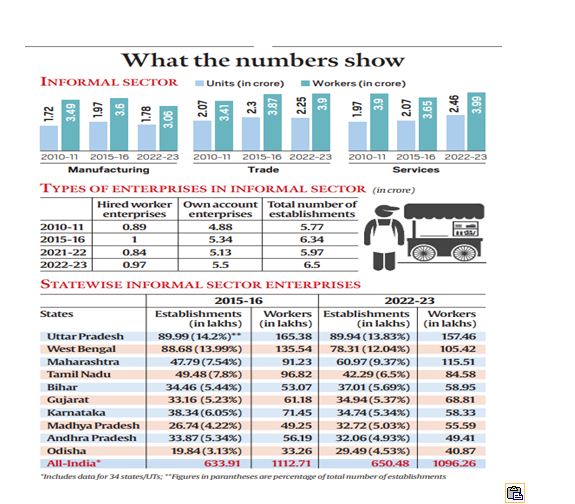July 20, 2024
The state of India’s informal economy:
Why in News ? The informal sector — small and medium enterprises and household proprietary and partnership establishments — accounts for almost half of India’s economic output and more than three-fourths of employment. But the sector faces challenges — over the last seven years, many units have shut and about 16.45 lakh jobs have been lost, data from the Annual Survey of Unincorporated Enterprises (ASUSE) show.
- Outcomes of the 2021-22 and 2022-23 surveys were released by the National Sample Survey Office (NSSO) recently. The data reflect the impact of three major exogenous shocks suffered by the economy — demonetisation (November 2016), the rollout of GST (July 2017), and the Covid-19pandemic (beginning March 2020).
- Informal manufacturing establishments were the worst affected compared to the pre-pandemic period. Most new jobs in the sector were created in own-account enterprises rather than hired-worker units, indicating a broad decline in employment quality.
What are unincorporated enterprises?
- These are enterprises in the unorganised or informal sector, comprising Micro, Small and Medium Enterprises (MSMEs), household units including those with hired workers, and own-account enterprises. The surveys were carried out for unincorporated non-agricultural establishments in three sectors: manufacturing, trade, and “other services”.
- Manufacturing units other than those covered under the Factories Act, 1948 and the organised manufacturing sector’s Annual Survey of Industries (ASI), have been surveyed, along with informal establishments engaged in cotton-ginning, cleaning, and bailing, and manufacturing bidi and cigar.
- Units for non-captive electric power generation, transmission, and distribution not registered with the Central Electricity Authority (CEA), are also covered.
- Under trade and other services, proprietary and partnership establishments (excluding Limited Liability Partnership establishments), society/ trust/ association/ club/ body of individuals etc., co-operatives, self-help groups, and non-profit institutions are included.
Why are these survey results important?
- Before the 2021-22 and 2022-23 rounds, the last available data were from 2015-16. Results of some previous rounds, for instance 2018-19, were not released.
- The informal sector plays a crucial role in generating jobs and absorbing especially semi-skilled and unskilled labour. It is closely watched for employment trends, especially when there is a slowdown in the formal sector.
- Data from the surveys help to understand the impact of the sudden withdrawal of cash from the system (2016), of regulatory compliances and inclusion in the tax net (2017), and of the national lockdown (2020-21), the brunt of which was borne by the informal sector.
What headline trends do the data show?
- The informal sector registered a decrease in employment, though the number of enterprises increased over the previous round both in 2022-23 and 2015-16. Own-account enterprises increased nearly 4% during the seven-year period, even as hired-worker enterprises contracted by 2%.
- This indicates a deterioration in the quality of employment as units shifted to self-owned units, that is, households or one-person units rather than hired-worker units, which are typically a source of labour-intensive enterprises, especially in manufacturing.
- As the economy moved to more capital-intensive manufacturing, the data indicate a dent in employment in labour-intensive manufacturing in the unorganised sector.
- This trend is reflected in the other dataset for employment, the Periodic Labour Force Survey (PLFS), which shows an increase in workers in agriculture over the past year, and a decrease in manufacturing.
- As per PLFS 2022-23, the share of persons employed in agriculture went up to 45.8% from 42.5% in 2017-18, with the share of women in agriculture rising sharply to 64.3% in 2022-23 from 55.3% in 2018-19. Most of this increase has been for unpaid household work.
- Surplus labour should typically move from the informal (including agriculture and construction) to the formal (manufacturing and high-productivity services) sector. However, there is no formal sector data to support this.
- Overall, the number of workers employed in the informal sector in 2022-23 dropped by 45 lakh (1.5%) to 10.96 crore from 11.13 crore in 2015-16. The number of unincorporated enterprises increased by 16.56 lakh to 6.50 crore in 2022-23 from 6.33 crore in 2015-16.

What is the trend across sectors?
- Manufacturing units were the worst hit, contracting 9.3% between 2022-23 and 2015-16 to 1.78 crore. The number of workers in manufacturing fell 15% to 3.06 crore during this period.
- Units in the trade sector contracted to a lesser extent — to 2.26 core, a 2% decline in 2022-23 from 2015-16. The number of workers increased marginally by 0.8% to 3.90 crore in this period.
- Services sector establishments, on the other hand, recorded increases in numbers of both units and workers — by 1% to 2.46 crore and by 9.5% to almost 4 crore respectively.
- Data over the last 12 years (dating to 2010-11), however, show that the numbers of both enterprises and workers grew at a better pace during the five years from 2010-11 to 2015-16 than in the subsequent seven years.
Gist of daily Article /The Hindu 17oct 2025
October 17, 2025
Daily Gist of the Hindu/Indian Express : 16 Oct 2025
October 16, 2025
Daily Gist of The Hindu/Indian Express: 6 Oct 2025
October 6, 2025
Daily Gist of Article /The Hindu /Indian Express: 24 Sep 2025
September 24, 2025
